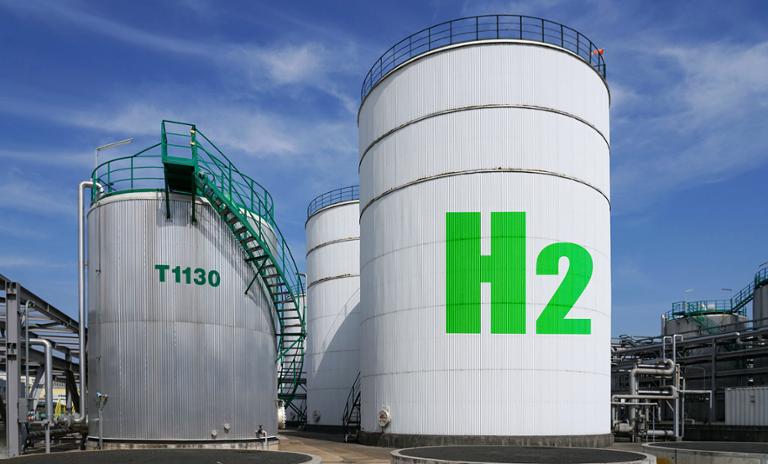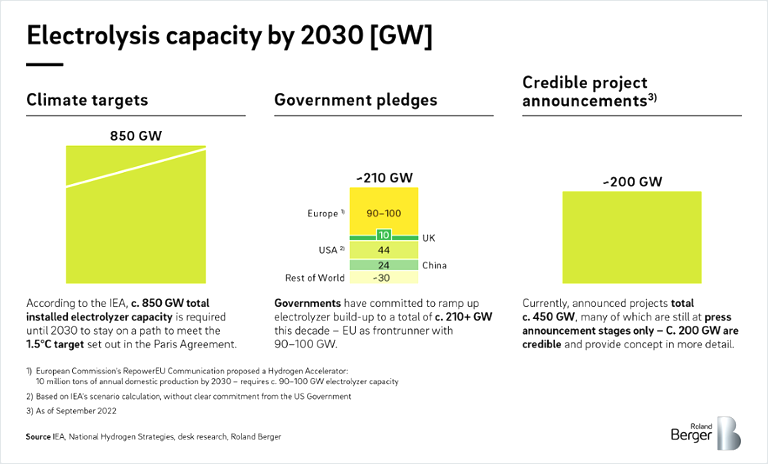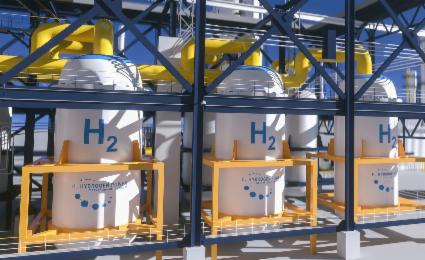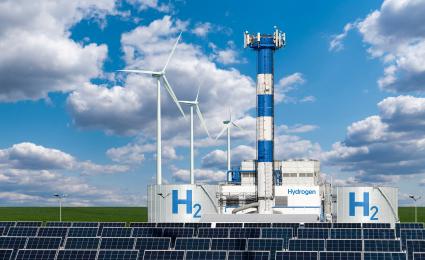Find out more about why it is time to industrialize manufacturing tech for equipment in the hydrogen economy.


Green H2 investments – Enabling clean energy and industry
Green Hydrogen: A Key Building Block of Climate Neutrality
Decarbonising our societies and economies is the transformational challenge of this century. The European Union (EU) is accelerating its path towards carbon neutrality with the Green Deal, setting the target of turning Europe into the first climate-neutral continent by 2050, and pledged to reduce emissions by at least 55% by 2030, compared to 1990 levels. To achieve this profound transformation towards a climate-friendly economy, the energy system will have to be reshaped in ways that go significantly beyond greening the power grid.

"Given the crucial role of green hydrogen for achieving a clean energy transition, policymakers across the world have been stepping up their efforts to facilitate the market ramp-up by committing to ambitious electrolysis capacity build-out targets."
While green energy is now a vital part of the electricity mix, the share of electricity used in overall energy consumption is still limited. For example, renewable energy sources contributed 38% to the overall European electricity mix in 2020, overtaking fossil fuels. But looking at the share of renewable energy in the overall economy, taking into account the transport sector, as well as heating and cooling, the share of renewables was substantially lower, around 22%. This is due to a number of structural challenges. Sectors such as heavy industry, with huge energy needs to process heat from burning fossil fuels, are notoriously difficult to electrify. The same holds true for heavy duty transportation. Moreover, there is a lack of grid infrastructure to transport green power from areas of production to centres of demand.
This is where green hydrogen has a key role to play. It can be used as a renewable fuel or feedstock in all major CO2-emitting sectors, including those where direct electrification is not possible. By producing hydrogen using electrolysis powered by renewable sources, green power becomes easier to store and transport as an energy carrier, enabling sector coupling. Besides green hydrogen that is produced from renewable energy sources, alternative technologies exist to produce hydrogen with low carbon content (so-called clean hydrogen). These include blue hydrogen, which is produced from fossil sources but with carbon capture, and pink hydrogen, which is produced from nuclear power using electrolysis. Clean hydrogen can be used as a combustion fuel in industrial or mobility applications, or be reconverted to electricity in a fuel cell. As a feedstock, clean hydrogen can replace grey hydrogen in industrial processes, such as refining. Taking things one step further, clean hydrogen-based derivative products, such as ammonia, methanol, or Fischer-Tropsch-based e-fuels, can serve as sustainable feedstocks and fuels. For example, green ammonia can be used for fertiliser production while synthetic jet fuel produced from green H2 can replace fossil-based kerosene in aviation.
Massive green H2 build-out will be required
Tackling climate change will require a substantial build-out of electrolysis capacity for industrial-scale green H2 production, as well as a corresponding ramp-up of renewable electricity generation capacity mostly from solar PV, onshore wind and offshore wind to feed the electrolysis plants. Despite the buzz around green H2, the installed base of electrolysis capacity today is still very limited at around 0.5 GW globally. Contrasting this with the green H2 capacity required to achieve climate neutrality clearly shows the magnitude of the challenge ahead. According to the International Energy Agency (IEA), 850 GW of electrolysis capacity would need to be in operation by 2030 to meet the net-zero emission scenario. Given the crucial role of green hydrogen for achieving a clean energy transition, policymakers across the world have been stepping up their efforts to facilitate the market ramp-up by committing to ambitious electrolysis capacity build-out targets, amounting to about 210 GW of pledged build-out by 2030. Europe is positioning as a front-runner, with ambitious targets set both by national governments, and at the EU-level. This momentum has been accelerated with the recent RePowerEU package put forth by the European Commission to achieve independence from fossil energy imports from Russia in light of the Ukraine war. The package foresees doubling the previous target for green H2 use in the EU, both from domestic production and from imports, to a total of 20 million tons by 2030. At the same time, credible project announcements currently stand in the order of about 200 GW of electrolysis capacity by 2030. On the one hand, this snapshot shows that the origination and development of viable projects is a key challenge. On the other hand, it illustrates the substantial opportunity and growth potential for real asset investors to drive new projects to meet the build-out targets.
Investments in H2 Technology and real assets on the rise
Looking at the financial investment perspective, the emerging green hydrogen economy is actually following a rather typical pattern for early-stage industries. In recent years, the strategic focus of investors has been largely on technology companies with strong IP and engineering capabilities required to produce industrial-scale green H2 equipment. These technology-focused investments covered the entire value chain. On the upstream side, electrolyser manufacturers have clearly been the focal point of investors’ attention. Midstream, investment activities were focused on technology players active in H2 conversion, storage, and transport technologies. Downstream, investors were targeting technology companies for various end-use applications, from mobility to stationary fuel cell applications. The industry has seen significant investment in a variety of forms, ranging from private series funding rounds, to IPOs in the start-up space, to spin-outs of the H2 business from established technology companies and conglomerates. Fuelled by the business prospects of the green energy transformation, valuations of publicly listed H2 technology companies have soared through 2020. After temporary setbacks in 2021, and general volatility from macroeconomic uncertainty, valuations have bounced back and H2 companies are currently trading around 65% above early 2020 levels. As a result, the industrial supply chain is now capitalised for a massive scale-up of its production capacities, moving from small-batch manufacturing to mass-production. The electrolyser industry illustrates this point, with global capacity set to increase more than six-fold from around 7 GW annual production capacity in 2022 to around 47 GW by 2025, based on the announcements of factory scale-ups by OEMs worldwide.
Large-scale project investments breaking through
The next step of scaling up the green H2 economy will now require putting the equipment to use in large-scale green H2 production projects. Consequently, the attention of financial investors is shifting towards the real assets space. While this includes first and foremost large-scale integrated renewables and green H2 production projects, adjacent investment areas are also in scope. Often, green H2 is not actually the final product to be consumed, putting the focus on subsequent steps of derivatives production, such as green ammonia or methanol. Additionally, there are no established, ready-to-use transport chains for green H2. As a result, investing in transport infrastructure, such as conversion/reconversion terminals and even ships, may be worthwhile, as well as a prerequisite for getting production projects off the ground and connecting supply and demand. Green H2 project announcements are skyrocketing, following a distinct geographical pattern. While Europe leads the pack in terms of number of projects, the announced projects are relatively small on average. Conversely, we see large-scale project announcements, mostly with a clear medium-term export orientation in global regions with a very low levelised cost of electricity (LCOE), namely in South America, Africa, the Middle East, and Oceania.
Tapping into the real asset opportunity for green H2
In the current, early stage of the green H2 market development, green H2 is not a liquid, globally traded product in the sense of a green commodity. Rather, the current market is driven by captive projects. These are integrated supply chains that de-risk both the required upstream large-scale investments in renewables and electrolysers as well as midstream transportation by obtaining captive, long-term offtake agreements, typically with a certain component of public funding support. Often, strategic investors, such as oil and gas companies or industrial offtakers of green H2 are the driving forces behind these projects, both as developers and equity investors in wider consortia. As a result of this captive, project-centered market structure, we see three archetypes of projects in the emerging green H2 economy:
- Local, small-scale & mobility-focused
- Local, medium-scale & industry-focused
- Larger-scale, international & export-focused
While local, mobility, centered projects are fairly advanced throughout Europe, with sizeable H2 fuel cell bus fleets operational in municipalities across the continent, the limited size of these projects makes them less relevant for financial investors. Archetypes 2 and 3, however, should be the focus of investors for a number of reasons:
- Given the scale of these projects, meaningful investment ticket sizes can be achieved.
- As projects mature, moving from the drawing board towards final investment decision (FID), strategic investors move their H2 activities from on-balance-sheet innovation budgets to project financing, and are increasingly open to bringing additional institutional investors on board to mobilise the capital required for capital investments.
- These projects are typically designed around large-scale industrial offtakers with strong balance sheets, enabling offtake de-risking and improving the prospects for bankability of projects.
- Captive projects typically follow a step-wise approach, with a medium-sized first stage and substantial scale-ups in later years, in line with the market ramp-up. Taking an investment stake in the first stage can be crucial to securing favourable positioning when expansion stages need to be financed a few years down the road.
Three success factors are key for project investments
The real asset investment opportunity in green H2 is unfolding, as the world is moving towards a decarbonised energy and industry system. But much of the project landscape is still uncharted territory for institutional investors. Just like in any early-stage industry, being mindful of the underlying challenges and taking a highly selective approach is crucial to investing successfully. Given the captive nature of the market, prospective investors need to gain a deep and thorough understanding of individual project investment opportunities to gauge their commercial prospects and risks. Specifically, three main success factors need to be in place for projects to yield meaningful investment opportunities:
- Secured offtake: Projects need to have binding, multi-annual offtake commitments as a starting point and should be structured based on viable underlying commercial models, to enable commercial de-risking and, ultimately, bankability. In the early stages of the market, this will in many cases include a public funding component to cover the cost premium of green H2 vs grey H2 from legacy technologies.
- Access to low-cost, high-load renewables: The cost of renewable electricity is the key make-or-break factor of the business case for green H2 production. Achieving a high load factor for the electrolyser is crucial to optimise the utilisation of electrolysis plants. In practice, this can typically best be achieved by combining different renewables sources, such as wind and solar PV, with complementary power profiles, as well as storage solutions. Choosing strategic project locations with access to low-cost renewables and high load factors is thus a key determinant for achieving competitive H2 production costs.
- Viable transport set-up: Connecting supply and demand via transport is for the new H2 economy – and in fact one of the most critical practical barriers for the market ramp-up [ROL].* Four main technology routes are conceivable today: pipeline transport, green ammonia conversion and re-conversion, liquid organic hydrogen carriers (LOHC), as well as liquid H2. There is no one-size-fits-all carrier that outperforms the other technologies across use-cases. For example, regardless of the considerable costs of liquefaction and cooling, liquid H2 might still be a better option if high-purity liquid hydrogen is required at the point of use. The most economical option for any given scenario will ultimately have to be determined on a concrete use-case basis for each project.



_image_caption_none.png?v=770441)





